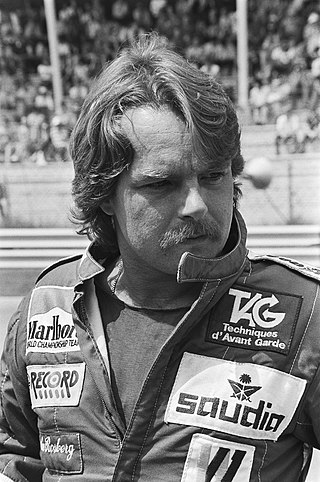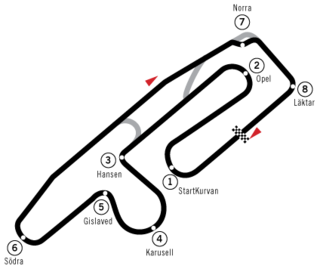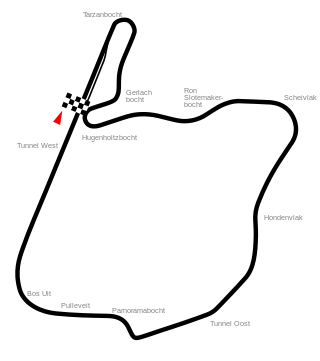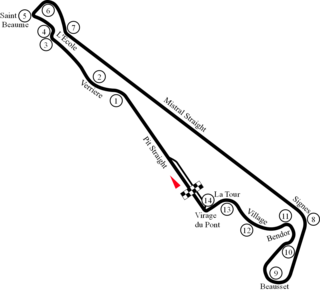
Keijo Erik Rosberg, best known as "Keke", is a Finnish former racing driver and winner of the 1982 Formula One World Championship. He was the first Finnish driver to win the championship. He is the father of Nico Rosberg, the 2016 Formula One World Champion.

The 1974 Brazilian Grand Prix was a Formula One motor race held at Interlagos on 27 January 1974. It was race 2 of 15 in both the 1974 World Championship of Drivers and the 1974 International Cup for Formula One Manufacturers. The 32-lap race was won by McLaren driver Emerson Fittipaldi after he started from pole position. Clay Regazzoni finished second for the Ferrari team and Lotus driver Jacky Ickx finished in third place.

The 1974 Spanish Grand Prix was a Formula One motor race held on 28 April 1974 at the Circuito Permanente del Jarama near Madrid, Spain. It was race 4 of 15 in both the 1974 World Championship of Drivers and the 1974 International Cup for Formula One Manufacturers.

The 1974 French Grand Prix was a Formula One motor race held at Dijon-Prenois near Dijon, France on 7 July 1974. It was race 9 of 15 in both the 1974 World Championship of Drivers and the 1974 International Cup for Formula One Manufacturers.

The 1974 Italian Grand Prix was a Formula One motor race held at Monza on 8 September 1974. It was race 13 of 15 in both the 1974 World Championship of Drivers and the 1974 International Cup for Formula One Manufacturers. The 52-lap race was won by Lotus driver Ronnie Peterson after he started from seventh position. Emerson Fittipaldi finished second for the McLaren team and Tyrrell driver Jody Scheckter came in third.

The 1974 Canadian Grand Prix was a Formula One motor race held at Mosport Park on 22 September 1974. It was race 14 of 15 in both the 1974 World Championship of Drivers and the 1974 International Cup for Formula One Manufacturers.

The 1975 Argentine Grand Prix was a Formula One motor race held at Buenos Aires on 12 January 1975. It was race 1 of 14 in both the 1975 World Championship of Drivers and the 1975 International Cup for Formula One Manufacturers. It was the twelfth Argentine Grand Prix and only the second to be held on the lengthened six kilometre version of the race track that runs out towards Curvon Salotto around the lake which lies to the north-east of the circuit.

The 1975 Brazilian Grand Prix was a Formula One motor race held at Interlagos on 26 January 1975. It was race 2 of 14 in both the 1975 World Championship of Drivers and the 1975 International Cup for Formula One Manufacturers. It was the fourth Brazilian Grand Prix since its introduction in 1972. The race was won by São Paulo native Carlos Pace driving a Brabham BT44B. It was the only win of Pace's career; he was killed in an aircraft accident two years later. Fellow Brazilian Emerson Fittipaldi finished second in his McLaren M23 with his German teammate Jochen Mass finishing third.

The 1975 Monaco Grand Prix was a Formula One motor race held in Monaco on 11 May 1975. It was race 5 of 14 in both the 1975 World Championship of Drivers and the 1975 International Cup for Formula One Manufacturers. It was the 33rd Monaco Grand Prix since the race was first held in 1929. It was held over 75 of the scheduled 78 laps of the three kilometre street circuit, for a race distance of 245 kilometres.

The 1975 Swedish Grand Prix was a Formula One motor race held at the Scandinavian Raceway at Anderstorp on 8 June 1975. It was race 7 of 14 in both the 1975 World Championship of Drivers and the 1975 International Cup for Formula One Manufacturers. It was the sixth Swedish Grand Prix after it was first held as the Swedish Summer Grand Prix in 1933, and the third to be held at Scandinavian Raceway. It was held over 80 laps of the four kilometre circuit for a race distance of 322 kilometres.

The 1975 Dutch Grand Prix was a Formula One motor race held at Circuit Zandvoort on 22 June 1975. It was race 8 of 14 in both the 1975 World Championship of Drivers and the 1975 International Cup for Formula One Manufacturers. It was the 24th Dutch Grand Prix. It was held over 75 laps of the four kilometre circuit for a race distance of 318 kilometres.

The 1975 French Grand Prix was a Formula One motor race held at Paul Ricard on 6 July 1975. It was race 9 of 14 in both the 1975 World Championship of Drivers and the 1975 International Cup for Formula One Manufacturers. It was the 53rd French Grand Prix and the third to be held at Paul Ricard. The race was held over 54 laps of the 5.8-kilometre (3.6 mi) circuit for a race distance of 313 kilometres (194 mi).

The 1975 British Grand Prix was a Formula One motor race held at Silverstone on 19 July 1975. It was race 10 of 14 in both the 1975 World Championship of Drivers and the 1975 International Cup for Formula One Manufacturers. It was the 30th British Grand Prix to be held since the race was first held in 1926 and the 17th time the race had been held at Silverstone. The race was held over 56 of the scheduled 67 laps of the four kilometre venue for a race distance of 264 kilometres. This was the first race that used the traffic light system with coloured lights at the start.

The 1975 Austrian Grand Prix was a Formula One motor race held at Österreichring on 17 August 1975. It was race 12 of 14 in both the 1975 World Championship of Drivers and the 1975 International Cup for Formula One Manufacturers. It was the eighth Austrian Grand Prix and the sixth to be held at the Österreichring. It was held over 29 of the scheduled 54 laps of the six kilometre circuit for a race distance of 171 kilometres. The race was shortened by heavy rain, meaning that only half points were awarded. The weekend itself was marred by the deaths of Mark Donohue and a track marshal in a practice crash.

The 1975 Italian Grand Prix was a Formula One motor race held at Monza on 7 September 1975. It was race 13 of 14 in both the 1975 World Championship of Drivers and the 1975 International Cup for Formula One Manufacturers. It was the 45th Italian Grand Prix and the 41st to be held at Monza. The race held over 52 laps of the five kilometre circuit for a race distance of 300 kilometres.

The 1976 Monaco Grand Prix was a Formula One motor race held at the Monaco street circuit in Monaco on 30 May 1976. It was the sixth round of the 1976 Formula One season and the 34th Monaco Grand Prix. The race was contested over 78 laps of the 3.3 km circuit for a race distance of 257 kilometres.

The 1982 Brazilian Grand Prix was a Formula One motor race held at Jacarepaguá on March 21, 1982. It was the second round of the 1982 Formula One season. Many drivers suffered exhaustion because of the intensely hot weather, particularly Brabham drivers Nelson Piquet and Riccardo Patrese. Patrese was forced to retire from the race due to total exhaustion. Piquet, after having finished first in the race and then barely making it to the podium ceremony, fainted due to exhaustion only to be disqualified later.

The 1983 Monaco Grand Prix was a Formula One motor race held at Monaco on 15 May 1983. It was the fifth race of the 1983 Formula One World Championship. The 76-lap race was won by Finnish driver Keke Rosberg, driving a Williams-Ford, with Brazilian Nelson Piquet second in a Brabham-BMW and Frenchman Alain Prost third in a Renault. This was only time that both works McLaren cars failed to qualify for a race.
Fittipaldi Automotive, sometimes called Copersucar after its first major sponsor, was a Formula One racing team and constructor that competed from 1975 to 1982. It was the only Formula One team to have been based in Brazil. The team was formed during 1974 by racing driver Wilson Fittipaldi and his younger brother, double world champion Emerson, with money from the Brazilian sugar and alcohol cooperative Copersucar. The team raced under a Brazilian licence. Emerson Fittipaldi became a driver for the team in 1976 after leaving McLaren, but was unable to replicate his earlier success with the family-owned team. Future world champion Keke Rosberg took his first podium finish in Formula One with the team.
Walter Wolf Racing was a Formula One constructor active from 1977 to 1979, which won the first race the team entered. It was owned and run by Canadian Walter Wolf. The team was based in Reading, UK but raced with the Canadian licence.















